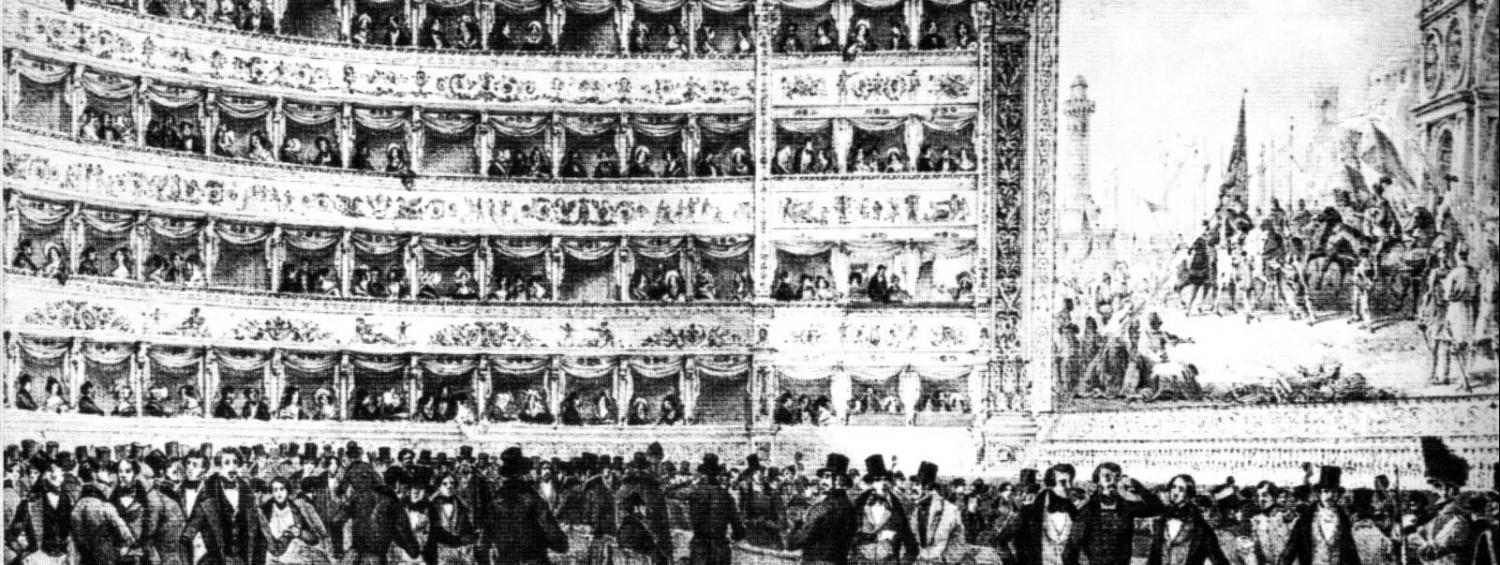Time has been flying lately at Olney. We just closed Oil on Sunday, Mary Stuart is beginning rehearsals on Monday, and Ken Ludwig’s A Comedy of Tenors will be opening on our Mainstage in just over one week. In honor of our next mainstage production, here is a brief history of opera and how the artform has evolved and survived for over 400 years.
Renaissance (14th-17th century)
Opera is a shortened form of the phrase “opera in musica,” or “work in music.” Opera was born in Italy during the Renaissance, a period in Europe between the 14th and 17th centuries that marked the transition from the middle ages to modernity. Art, literature, science, and politics were largely influenced by humanism, a kind of thought that emphasized the values, needs, and thoughts of humans over the divine.
During the Renaissance, people came to think of the human voice as the link between the earthly and divine. In Florence, the birthplace of opera, a group of humanists, musicians, and intellectuals known as the Florentine Camerata sought to recreate Greek and Roman dramas through music. In the 16th century, Florence already had a history of musical theatre. Intermedi were short musical interludes that were presented between acts of plays in part to show the passage of time. They are considered to be an early ancestor of opera. Jacopo Peri’s La Dafne was performed in Florence during the Pre-Lenten Carnival of 1598. It is widely considered to be the first opera. Peri introduced the dramatic style of singing known as recitative, which imitates spoken language over musical melody. Peri described it himself as “more than speech but less than song.” After this, opera began to spread through Italy to Mantua, Rome, and Venice.
Baroque Era (1600-1750)
Following the Renaissance music era, the Baroque era lasted from about 1600-1750. At this time, opera began flourishing throughout Europe. In 1637, the first public opera house, Teatro di San Cassiano, opened in Venice. This marked a turning point in opera’s role in a society. Opera was no longer solely performed in a court for nobility, as it had been before. It was now available to members of the public. By 1700, nine commercial theatres were open in Venice, several of which were devoted to opera. With more opera being produced for the public, competition rose and the content of the operas began to evolve. Plots favored scandal and disguise, and style became more grandiose and technically demanding. The form of dramatic singing moved away from recitative and toward aria, long melodic songs for one voice. Castrati were also introduced to opera practices. Castrati were male singers who were castrated before puberty in order to preserve their youthful soprano voices. These singers usually portrayed female characters in operas.
Classical Period (1750-1830)
Following the elaborate styles of the Baroque Era, the Enlightenment ushered in an artistic movement that favored rational plots and simpler styles. Also known as the Age of Reason, the Enlightenment promoted science and human progress through intellectualism. The Classical Era was marked by two popular opera styles: opera seria and opera buffa. Interestingly, these contrasting styles illustrated a major tension of the time between the upper and lower class. While opera seria drew more on formal conventions and Baroque opera styles, opera buffa was a newer style that encouraged more experimentation. Opera seria was catered toward the upper class, celebrated the aristocracy, and featured kings and other wealthy, powerful individuals. Opera buffa, in contrast, challenged the aristocracy and featured everyday people. During the Classical Era, Enlightenment thinking encouraged the growing middle class to challenge authority. A push for class equality and justice ultimately led to the birth of the French and American Revolutions.
One composer, Willibald Christoph Gluck, was known for his experimentation in nearly all operatic styles of his day. He blended international styles, including Italian opera seria, French opera comique, German singspiel, etc. Gluck and others helped to expand the artform by playing with structure, harmony, and story, moving away from formal conventions of the Baroque era. Gluck introduced the idea of “recitativo accompagnato,” which gave the orchestra a more integral role in the support of the human voice. Perhaps the most well-known classical composer was Mozart, a master of both farce (The Marriage of Figaro) and drama (Don Giovanni).
Romantic Period (1830-1900)
Opera during the Romantic Period rejected the science and reason of the Classical Era and instead allowed emotion to be the guiding force of the music. Operas became grander, more indulgent. The Italian bel canto (“beautiful singing”) movement favored singing that was ornate and controlled: “Using a relatively small dynamic range, bel canto singing was based on an exact control of the intensity of vocal tone, a recognition of the distinction between the “diapason tone” (produced when the larynx is in a relatively low position) and the “flute tone” (when the larynx is in a higher position), and a demand for vocal agility and clear articulation of notes and enunciation of words.” (Bel Canto)
Tragedies were very popular at the time, particularly when they featured characters who descended into madness (i.e. Gaetano Donizetti’s Lucia di Lammermoor). Stories in praise of liberty and freedom were also frequent, in response to the French Revolution (1789-1799). “Rescue operas” emerged, usually depicting a hero or heroine as a political prisoner in need of rescue. Italian composer Giuseppe Verdi contributed many dramas, including La Traviata, Otello, Don Carlo, Aida, and Nabucco. German composers, including Carl Maria von Weber and Richard Wagner, composed many ambitious and mythic pieces. In France, historical epics became popular. Russian composers, namely Mikhail Glinka and Pyotr Tchaikovsky made their first major contributions to opera, mainly focusing on history and fantasy.
Twentieth Century
Toward the end of the 19th century, the Italian trend of verismo encouraged a more realistic approach to opera’s subject material. Giacomo Puccini is the best known composer of this movement, with works that are frequently performed today, including La bohème (1896), Tosca (1900), and Madama Butterfly (1904). The twentieth century saw some experimentation, but was mostly marked by the continuing reign of Romantic operas. It became more common to use smaller orchestras in order to create a sense of intimacy. Many composers including Richard Strauss, Dmitri Shostakovich, and Benjamin Britten created work in response to psychological discoveries or political events of their times. One of the most notable operas of recent history is John Adams’ Nixon in China (1987), a political piece that narrates Richard Nixon’s diplomatic visit to China in 1972.
Sources:
“A Brief History of Opera.” SFOpera, sfopera.com/discover-opera/intro-to-opera/a-brief-history-of-opera/.
Boundless. “Boundless Art History.” Lumen, courses.lumenlearning.com/boundless-arthistory/chapter/the-enlightenment/.
Britannica, The Editors of Encyclopaedia. “Bel Canto.” Encyclopædia Britannica, Encyclopædia Britannica, Inc., 21 Jan. 2016, www.britannica.com/art/bel-canto.
“Classical Era Opera: Mozart and Popular Operas.” Study.com, Study.com, study.com/academy/lesson/classical-era-opera-mozart-and-popular-operas.html.
Hall, George. “Opera through the Ages.” The Guardian, Guardian News and Media, 19 Aug. 2011, www.theguardian.com/music/2011/aug/20/opera-through-the-ages.
“Opera Timeline.” Oxford Music, www.oxfordmusiconline.com/page/opera-timeline.
“Opera's History.” Opera History | The Opera 101, www.theopera101.com/operaabc/history/.
“Radio 3 - Opera - Timeline.” BBC, BBC, www.bbc.co.uk/radio3/opera/timeline/.
Weinstock, Herbert, and Barbara Russano Hanning. “Opera.” Encyclopædia Britannica, Encyclopædia Britannica, Inc., 19 July 2018, www.britannica.com/art/opera-music.







